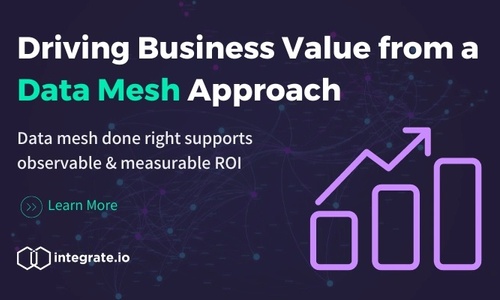Irrespective of what it’s called, the market has talked about what amounts to data mesh for several years. The concept of decentralized data management that is driven by business domains helps support the need for business-focused data outcomes. It also helps place value on where the value of data projects should be - on business needs. Data driven organizations need to look at business domains as a way of organizing the various desired outcomes of analytics and data movement initiatives. For instance, bringing together data across disparate systems creates visibility into operations. For healthcare, this might mean managing patients or areas of clinical research, whereas for manufacturing, this might mean managing parts or quality control. The list is endless, but looking at data based on domain helps organizations link data and processes, so that both operations and analytics can be taken into account in the same effort.
At the same time, organizations risk redundancies as data stored by business domain might overlap across use cases, adding complexities to data management. In the past, some of these redundancies pushed organizations towards a data warehouse or data lake approach to access data when needed. Only using this approach enables potential gaps in insights as analytics weren't designed to take into account specific use cases and business domains.
Basically, there is no one right answer for organizations and most will see their data warehouses used side by side a data mesh approach. In general, data mesh lets organizations focus on their business challenges and the insights they want based on data that is needed. This helps create data pipelines that are focused on the business outcomes and not simply on data movement or consolidation.
Why this matters to business
Organizations should be considering data mesh along side a data warehouse to ensure that overall business alignment with IT and needs are being met. This matters to business leaders and key business domain stakeholders because it creates:
- Better cohesion between IT/data teams and LOB (Line of Business): Focusing on the way business processes work to align business rules with data pipeline creation provide more ways for collaboration across stakeholder groups.
- Outcomes that are driven by business challenges and opportunities: Instead of driving projects from a data perspective, organizations start from the business perspective to understand how data assets can be pulled together across the organization and how data interrelates across functions.
- More intuitive ways of managing data governance: Organizations consistently struggle with governance. Business domains help identify who should be responsible for which data assets so that a framework can be developed and managed with the right stakeholders managing the right data components.
- An outcomes-driven approach to analytics and data pipeline creation: Data pipelines require more than just moving data. Data mesh broadens data integration to integrate business needs with data movements.
Data mesh done right supports observable and measurable ROI
The true value of data mesh is that it breaks down barriers to data visibility. Organizations move data all the time and build pipelines to load data into operational data sources or data warehouses, etc. The benefit to data mesh is that it takes things one step further by enabling data pipelines to drive business outcomes. Business domain focus ensures that silos are broken down to increase data visibility, giving analytics consumers better insights and letting people interact with data more seamlessly.





